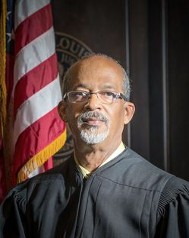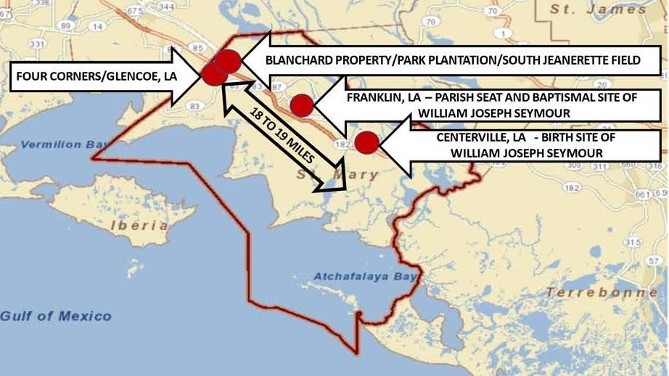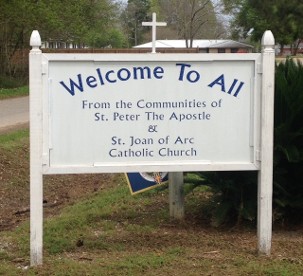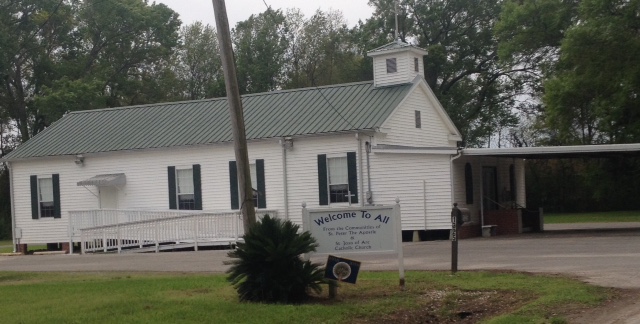This page last revised on 06.27.2021
It is possible certain links might not display linked documents. That happens during revisions of this page. Links are being reinstalled as discovered. In the interim, a visitor can check back or contact the author for the document that you may be trying to link to.
+++++++++++++++++++++++++++++++++++++++++++++++++++++++++++++
The Blanchard V Litigation is the latest in the Blanchard series of litigations that have been litigated across multiple courts in Louisiana (mostly St. Mary Parish) since 1986. "Blanchard" was an elderly widow who owned lands rich in minerals and her politically-connected Louisiana attorney (and his oil and gas business associates) wanted them and were willing to clandestinely try and take them from her. At the same time, the political influence was there to allow ARCO (now BP) and Texaco (now Chevron) avoid full environmental remediation of her property. It should not be forgotten that the Blanchard property (Park Plantation) is but one landowner in the South Jeanerette Field in St. Mary Parish. So, the environmental concerns on Park Plantation extend over into all properties operated by ARCO/BP and Texaco/Chevron.
For a better understanding about the underlying activities and the motivation moving the author to now addressing them by this webpage venue (and no longer the courts), please consider visiting other pages on this website titled:
Louisiana - The Darker Side
Louisiana - The Darkness of "Just-Us"
+++++++++++++++++++++++++++++++++++++++++++++++++++++++++++++
The Blanchard V Litigation
(St. Mary Parish Docket No. 132659)
PAUL MACLEAN
VS.
BP/ARCO;
CHEVRON USA HOLDING, INC;
TEXACO EXPLORATION AND PRODUCTION COMPANY;
MARATHON OIL COMPANY;
TORTUGA OPERATING COMPANY;
TORTUGA INTERESTS, INC;
BLANCHARD 1986 LTD;
JOHN E. HINE; AND
PETER L. TURBETT
This litigation was filed by this author in July of 2018 in St. Mary Parish, Louisiana by R. David Brown, Attorney. It was the fifth "Blanchard" litigation that has attempted to adjudicate the issue of stored public hazards on Park Plantation and the conversion of the funds derived from the mineral of Park Plantation. As in all other previous Blanchard litigations, this action was dismissed without adjudication.
This litigation was correctly filed in State Court in St. Mary Parish to set aside a purported 1996 settlement agreement that the author contends was intentionally devised, constructed and executed to at least avoid the full environmental remediation of Park Plantation in St. Mary Parish. According to Louisiana Office of Conservation and Louisiana Department of Environmental Quality public records, those unlawful acts likely affected St. Mary Parish's public health, adverse to public environmental law and policy of the State of Louisiana enacted to protect the health, safety and welfare of the people (see ARTICLE IX, 1. Natural Resources and Environment; Public Policy). The Louisiana Court System has aided the potential responsible parties in violating Article IX.
In 1996, the defendants moved to violate the objectives of Article IX when inextricably-connected exhibit documents were exchanged with a set of documents that had not been previously approved by the plaintiffs' attorney in The Blanchard I Litigation (G. Tim Alexander, III). In other words, some sort of "document switch" occurred after Betty Blanchard and this author executed the base agreement. Those uninitialed pages have assisted in the subject property not being fully remediated of all contaminates.
This "document switch" can be verified by simply viewing the purported final settlement agreement (with its final exhibits) as put forth by the defendants. The initials of G. Tim Alexander, III, ("GTA") in the bottom right-hand corner of all the exhibits are noticeably absent. Initials that were mandeated to be there.
This author has never been allowed to present and/or argue this in any State Court of Louisiana. Extreme acts of wrong-doing by this court and at least two previous courts in Louisiana have kept that from happening.
If allowed to present this argument in St. Mary Parish during The Blanchard V Litigation (or even in Jefferson Parish in The Blanchard III Litigation [see that litigation on the legend at the left]), it is believed that would have led to the purported 1996 settlement agreement being set aside as void ab initio (void from its beginning).
Simply put, the defendants cannot avoid a lawful full environmental remediation by self-constructing and using an unlawful settlement agreement. Louisiana State laws do not allow that. In fact, the settlement agreement itself states that it "shall be construed and interpreted in accordance with the laws of the State of Louisiana" (11.0 Governing Law).
To support the belief that the author would prevail with those facts and in that argument in State Court, if allowed, they were vigorously and successfully pro se argued in Federal Court in The Blanchard IV Litigation. (See that litigation in the legend on the left). That final lower court decision was affirmed by the Federal Court of Appeal in New Orleans.
To further support that the void ab initio argument would was a real one and likely to prevail, after the favorable decision in the Blanchard IV Litigation in Federal Court and before anyone knew that the author was going to intervene in the Blanchard III Litigation in Jefferson Parish, Judge Stephen Windhorst ruled against the defendants in regard to an exception of 8.) No Right of Action he ruled:
"Denied in part in that plaintiffs allege that settlement is null and void under C.C.P. art. 1426(D) and that under provision (E) any substantially affected person has standing to contest an agreement or contract contrary to public health pursuant to paragraph (D) of C.C.P. art. 1426."
Then later, Judge Windhorst ruled in regard to exception of 10.) Prescription:
Denied as to absolute nullity claim (C.C.P. art. 1426 -option). The plaintiffs have alleged allegations of concealment of public hazard under C.C.P. art. 1426(D) and (E) sufficiently in the petition. This claim would fall under the absolute nullity category and is thus not susceptible to prescription. An absolute nullity may be raised anytime and doesn't prescribe. Thus on the face of the plaintiffs petition this claim is not prescribed and defendants failed to sustain their burden of proof.
Denied as to absolute nullity claim (C.C.P. 1426). An absolute nullity claim does not prescribe thus on the face of the petition this claim is not prescribed.
This author was a party plaintiff in the Blanchard I Litigation and therefor was:
1. A "substantially affected person" with standing to intervene in the Blanchard III Litigation.
2. An "indispensable party" with standing to intervene in the Blanchard III Litigation.
When this author actually set out to do that after a favorable decision in the Blanchard IV Litigation in Federal Court the Jefferson Parish Court denied that right. For more on how the author was vicimized, please visit webpage titled "The Blanchard IV Litigation" as shown on the legend on the left.
The October 22, 2018 decision to dismiss this Blanchard V Litigation by Judge Lewis Pitman against the filer/author was appealed to the First Circuit Court of Appeal in Baton Rouge in early 2019. Again due to corrupt court record issues (as many times in the Blanchard-connected litigations [see Paul Maclean vs. G. Tim Alexander, III, et al Litigation in the legend on the left), this author relunctantly decided to dismiss the appeal and that dismissal was signed on August 7, 2019.
Why choose to dismiss? The district court record was lodged at the Court of Appeal lacking at least two material filings in St. Mary Parish District Court. Both of them self-generated by the court. Both of them important and absolutely required to fully argue the facts and the law in the Court of Appeal.
After motion to the court, the First Circuit Court of Appeal chose to not make the district court supplement the record with those filings in a timely and fair manner. Without those two filings being included in the record, there were no written reasons in the record from which to fully argue an appeal that, if they had been there in the filer's opinion, would have resulted in a reversal of the district court's decision to dismiss.
Whatever the remedy might have been, it would involved more money being thrown down a self-serving "judicial rathole" either in Baton Rouge or in St. Mary Parish just to get a full and completely accurate trial record from which to argue! A record the filer had just paid $2,641.50 to obtain!
This author had been there in St. Mary Parish once before and experienced not being able to obtain full and correct records. In 2003 this author pled pro se to the Louisiana Supreme Court over the need for a full and complete court record from which to argue. For that, please visit the webpage titled Paul Maclean vs. G. Tim Alexander, III, et al.
Therefore, another Blanchard litigation has come to an apparent end with the Blanchard facts never being fully adjudicated on their merits. Yet again, the court has materially influenced the outcome of a Blanchard or Blanchard-connected litigation, to the detriment of the author and to the court's benefit. Yet again, less than full and complete court records were used to do that.
A SHORT SUMMARY:
STRIKE NO. 1: In 2001, the court changed (and would not correct) material verbiage in an open court transcript of the Paul Maclean vs. G. Tim Alexander, III, et al Litigation in St. Mary Parish. G. Tim Alexander, III was the principal counsel of record for the plaintiffs, Mrs. Betty Blanchard (now deceased) and Paul Maclean, in the Blanchard I Litigation. The issues that surrounded the "Alexander" litigation, if adjudicated, would have shed much light as to why the 1996 purported settlement agreement was void ab initio. The defendants and their attorneys knew that. One can read more about the court and its representative in the "Alexander" litigation (with affidavits) on another page of this website titled Paul Maclean vs. G. Tim Alexander, III, et al.
STRIKE NO. 2: In or about 2014, the court lost or destroyed the entire litigation record pertaining to the author and his attempted intervention into the Blanchard III Litigation in Jefferson Parish. One can read much about that litigation (with affidavits) on another webpage in this website titled the Blanchard III Litigation.
STRIKE NO. 3: Now again, for the third time, in this litigation, the court denied the author a full and complete record from which to fully argue an appeal.
In the present litigation, the strange happenings within the court record go even further and gets even worse than before. While in St. Mary District Court, the critical written reasons for judgment were first signed by a judge that had absolutely no administrative connection at all to this litigation. After the plaintiff/author brought that strange fact to the attention of the court, It was eventually signed by the proper judge. How did that happen? No explanation was given.
Then, when the record was transmitted to the Court of Appeal, no written reasons for judgment at all were included in the record to lodge the appeal. Neither the one first signed by the wrong judge nor the one signed by the correct judge.
Then, after being motioned, the Court of Appeal did not timely and fairly permit the record to be supplemented with both written reasons so that the filer could fully prepare an arguement from a complete record that would have included actions by both judges and the reasons.
After all the years of experience with the Louisiana "just-us" system, it was/is naturally this author's belief that the failure to timely and fairly grant the plaintiff/filer/author a full and complete record from which to argue the appeal is nothing more than the court again continuing to keep its previous actions secret.
Secrecy has been experienced throughout the Blanchard-related litigations that began in 1986 and now it has surfaced again in the Blanchard V Litigation. Secrecy for what reason, you ask? To protect others within the court system from their past actions!
Those actions began with Newman Trowbridge, Attorney (now deceased), and his law firm associates in St. Mary Parish and has spread to many others over the years. In the Blanchard-related litigations, in the author's opinion, that has led to a extreme violation of the author's civil rights and the due process rights owed to any citizen.
Enough with the secrets! For 35+ years, parties of the court have relied on secrets to accomplish a specific "end" always to the detriment of Mrs. Betty Blanchard and Paul Maclean. This journey has been a long and expensive one taken in the court system because the author naively believed in a fair and reliable judicial system. One that would eventually yield justice to the party that persisted with the truth. What has been seen instead has been a system of "just-us"! A travety of justice.
The trail of deceit first began in 1985/86 when members of the court first protected a powerful politically-connected attorney (and his oil and gas business associates) for their admitted actions against Mrs. Betty Blanchard, an elderly widow, who was the attorney's client. The juidicial power possessed by one person made good people do bad things for reasons only they know.
After Newman Trowbridge died in 2009, and the filer continued to pursue the wrongdoings, the need for "secrecy" evolved into actions taken by the court to keep earlier actions taken by the court to protect one attorney prior to his death. The court has now actually become a "slave" onto itself trying to protect itself from public knowledge of its own wrongdoings over the years. The court is no longer free to do the right thing in regard to the Blanchard-connected litigations. To do the right thing would be to reveal all the court has done over the years in its effort to obtain judicial protectionism.
A serious question must be asked! If the court can and will do this during the Blanchard litigations, how many times has it done this in other litigations as well? It is highly unlikely the Blanchard litigations are the only ones impacted by such wrongdoings! A review of Ms. Nancy Blanchard's affidavit as part of the webpage titled Paul Maclean vs. G. Tim Alexander, III, et al leads one to believe that.
This litigation itself:
The Blanchard V Litigation is not a complicated action. In fact, it is quite simple.
The defendants have argued that their sole exception is res judicata. In using that single defense, the defendants cited two previous Blanchard litigations. Of course, the plaintiff/author rightfully took issue with that sole legal exception. No Blanchard litigation has ever been fully adjudicated on the merits.
But if it ever was adjudicated in a fair court venue, the facts and the law would force their arguments to fall like a "house of cards" and the 1996 settlement agreement, that purportedly settled the original Blanchard I Litigation, would be found to be void ab initio (void from the beginning). That absolutely null agreement, was unlawfully constructed in 1995 and 1996 in part to conceal public hazards on Park Plantation and to unlawfully convert mineral income from Park Plantation.
The two litigations that were cited by the defendants to plead a res judicata defense were:
1. The Blanchard II Litigation
Significantly, the author was never a party to that 2001 Federal litigation. Never joining the litigation or being joined to it by the defendants. In the author's lay opinion, Magistrate Judge C. Michael Hill's July, 2002 Report and Recommendation (that was accepted by Judge Tucker Melancon with no changes) was at its best a very lengthy "academic" endeavor that unnecessarily clouded a simple flaw in the initial filing of the Blanchard II by the plaintiff.
The flaw: Park Plantation, LLC (the plaintiff) was not even in existence during any part of the Blanchard I litigation: therefore, it had no standing to bring the 2001 Blanchard II litigation, in the first place. That is really all that had to be written by Magistrate Judge Hill. Instead he bloviated on all matters of fact and law of any sort and nature and thereby convoluted and confused what could have been a very simple decision. Park simply had no standing to have a cause of action. Magistrate Judge Mildred Methvin understood this when she prepared her 2007 Report and Recommendation for the Blanchard IV Litigation in Federal Court.
The Blanchard II Litigation, to which the author was never a party, has not been fully adjudicated on its merits. This litigation fails the test for res judicata.
Should the visitor want to read Magistrate Judge Mildred Methvin's 2007 Report and Recommendation, please visit the webpage titled "The Blanchard IV Litigation".
2. The Blanchard III Litigation
After a favorable decision by Magistrate Judge Mildred Methvin in Federal Court in the Blanchard IV Litigation and a favorable decision in Jefferson Parish by Judge Stephen Windhorst (earlier in part cited) in favor of the Blanchard's in the Blanchard III Litigation, the door was then opened for the author to intervene in the Blanchard III Litigation in Jefferson Parish. That should have been quite easy to do based on previous opinions and filings, correct? No way!
The author, being indispensible to the Blanchard series of litigations, had sufficient standing to intervene for many reasons. Therefore, the author filed to intervene in The Blanchard III Litigation. Mr. R. David Brown was his attorney. It took extreme actions by the court itself to interfere with that intervention. Ultimately, that interference caused the author to fail to become a party to the Blanchard III Litigation. One can read more about all that by clicking on The Blanchard III Litigation page on the upper legend of this website.
This cited Blanchard III Litigation, to which the author was never a party, has not been fully adjudicated on its merits. Even if it had been fully adjudicated on its merits, since the author was refused the right to intervene to become a party, this litigation also fails the test for res judicata. The author, being a "substantially affected person" and an "indispensable party" was injured in all these court actions carried out against him.
For the defendants to use the two above-cited litigations as the basis for the sole exception of res judicata defense when the plaintiff was never a party in either litigation and/or each was never fully adjudicated on its merits is a nonsensical position. Makes one think that the plaintiffs may have known what was going to happen in that court in St. Mary Parish.
A few filings of interest in The Blanchard V Litigation:
October 22, 2018: Testimony from the Hearing before Judge Lewis Pitman.
October 29, 2018: Judgment - Please note in the transcript above that there are NO ORAL REASONS ASSIGNED WITHIN JUDGE LEWIS PITMAN'S JUDGMENT, as the judgment stated existed.
January 30, 2019: Written Reasons for Judge Pitman's decision from the bench on October 22, 2018. A few problems with these written reasons!
First, they were not verbally assigned in open court on October 22, 2018, as the judgment stated they were.
Secondly and most importantly, after waiting for approximately three (3) months for the written reasons to be considered, written and supplied to the plaintiff/author, the final product was received not signed by Judge Lewis Pitman! The written reasons were signed by Judge Curtis Sigur!

District Judge Curtis Sigur.
The good Judge Curtis Sigur has no known direct professional connection to (or oversight of) the Blanchard V Litigation. Yet, he somehow signed the first written reasons dated January 30, 2019. How did that happen? No explanation has ever been given either by the St. Mary Parish court and/or numerous other attorneys/judges from other places that have opined on this fact. If there is any party out there that can reasonably explain this, please contact the author.
But there is a personal connection:
Interestly, Judge Sigur (and his extended family) IS likely unknowingly and personally connected to the environmental impacts connected to the series of Blanchard and Blanchard-related litigations have tried to address for years.
Born on December 8, 1957, Judge Sigur was reared in the Glencoe/Four Corners area of St. Mary Parish. ARCO was operating at that time in the South Jeanerette Field (on Park Plantation and many other tracts of land) just northerly of those two communities.
Those same areas were/are potentially being environmentally impacted by the public hazards generated and left on site by those ARCO operations. A reading of the Louisiana Office of Conservation (LOC) environmental records and particularly the letters written to that office by Mr. Austin Arabie, an environmental expert, on behalf of Ms. Nancy Blanchard, leads one to believe that environmental hazards are likely migrating southerly from Park Plantation toward Glenco/Four Corners. These public hazards are in part what the Blanchard litigations have been about since 1986. It is highly likely that Judge Sigur's family and friends in the Glencoe/Four Corners areas are some of the exact persons that have been greatly impacted by ARCO's operations in years past.
This is not an unwarranted claim. It has long been known that this rural, mostly minority community, has been impacted by environmental issues. There was testimony to the E.P.A about that in 2004. Click here to see that story.
To anyone that cares at all (and not many appear to care about these communities and the people that live there), even a simple review of the volumes of LOC and Louisiana Department of Environmental Quality (LDEQ) files would evidence numerous letters, reports and sample data connected to Park Plantation concerning the environmental conditions that were discovered and known there since 1986/87. Sadly, those facts are directly contrary to this false affidavit that was filed by the Office of Conservation on behalf of one of the defendants. What political power to get something like this done! (Note: This false affidavit was actually notarized by a law firm associate of Newman Trowbridge.)


Signs located on Hwy 318 just southerly of Four Corners, LA

Vicinity Map of St. Mary Parish Locations of Interest
The numerous files within the LOC and LDEQ are abundantly clear about the presence of environmental contaminants (public hazards). At the same time, just three miles away and southerly of the South Jeanerette Field, Four Corners has been identified as a "DRINKING WATER PROTECTION AREA" . Why is all this not being fully addressed? The people of Four Corners and Glencoe deserve better!


This failure of the State's regulatory agencies to act in a prudent and timely manner on Park Plantation (and the total South Jeanerette Field area) is directly in conflict with the expressed intent of the Louisiana State Constitution and why these agencies were actually created in the first place.
As shown above, unfortunately for the author and the public, a State regulator actually filed a false affidavit in the Blanchard I litigation, to the benefit of the polluters. It is known to be false by vast amounts of data over the years that have been filed in regulatory agencies. Even worse though, other LOC representative(s) latter testified in open court during the Blanchard I Litigation in support the defendant's false affidavit. Again, what political power to get something like this done!
Many other areas like Park Planation and South Jeanerette Oil and Gas Field and small, rural, mostly minority communities exist all across Louisiana. To think that State regulators are in control of such environmental remediation matters should be alarming to the public. Further, do not limit this to certain political parties. In the Blanchard matters, wrongful actions have crossed numerous governmental administrations is further proof of a "machine" that simply lives and thrives across political party lines.
After considering and in light of all the above, it is highly likely that the surface and groundwater and/or subsurface water remains not fully environmentally restored is in part because of a selective "just-us" system that has greatly benefitted the responsible parties for the contamination and not the general public.
Another interesting fact that shows what can happen. After all these years that Ms. Nancy Blanchard (the only child of Ms. Betty Blanchard) has vigorously filed and complained about the awful environmental contamination connected to Park Plantation, in a December, 2015 WARRANTY EASEMENT DEED IN PERPETUITY Nancy Blanchard actually stated in that easement that she had "no actual knowledge of a release or threatened release of Hazardous Materials, on, beneath, near or from the Easement Area". Interestingly, the public records clearly evidence that much of which has been filed over the years about Park Plantation, she had filed or was filed on her behalf. Prior to this easement, the record was quite clear about her position on the environmental contamination.
But, as one can read, when she stated that in 2015, she was apparently in the process of receiving at least $750,000.00 for an easement that adjoined the area identified as the most contaminated land on Park Plantation that had been subject to numerous environmental compliance orders for years. In fact, the compliance orders were actually identified in the servitude. To the best of the author's knowledge Ms. N. Blanchard still lives (at least part of the year) on lands covered by the servitude.
This is all very strange. Contaminated...not contaminated...$750,000 to the Park Plantation landowner... and for really what purpose! But, in the midst of all the contamination and money for whatever, let us never forget about the communities of Four Corners and Glencoe just a few miles away.
But communities as Four Corners and Glencoe have been suppressed for years in St. Mary Parish and elsewhere for years. For more about that, click here.
In the Blanchard V Litigation alone, this author has had to deal with:
1. A written judgment that stated there were reasons assigned from the bench for the judgment rendered but none were stated in the judgment.
2. Written reasons for the judgment that were first signed by a wrong judge.
3. No written reasons (either signed by the correct judge or the wrong judge) were included in the appeal record that was lodged at the First Circuit Court of Appeal.
4. When motioned to do so, the First Circuit Court of Appeal did not move for the written reasons to be timely and fairly included in the appeal record.
5. Paying court costs and copying costs while suffering all these "just-us" activities.
6. Continuing to pay attorney fees while all this court disfunction was going on at the First Circuit Court of Appeal.
We do truly consider all the good and sincere members of the bar that must work within such a corrupt "just-us" system alive and well in St. Mary Parish (and elsewhere) in the Blanchard litigations, but under the fear of disciplinary actions, they are compelled to be silent and keep "secrets". If you are one of those attorneys, remember, you are not the first to live under such ruthless oppression. Keep the faith! There is hope! If the public can begin to understand the depth of these secrets, that are being withheld from them, there will be meaningful change toward real justice!

St. Thomas More